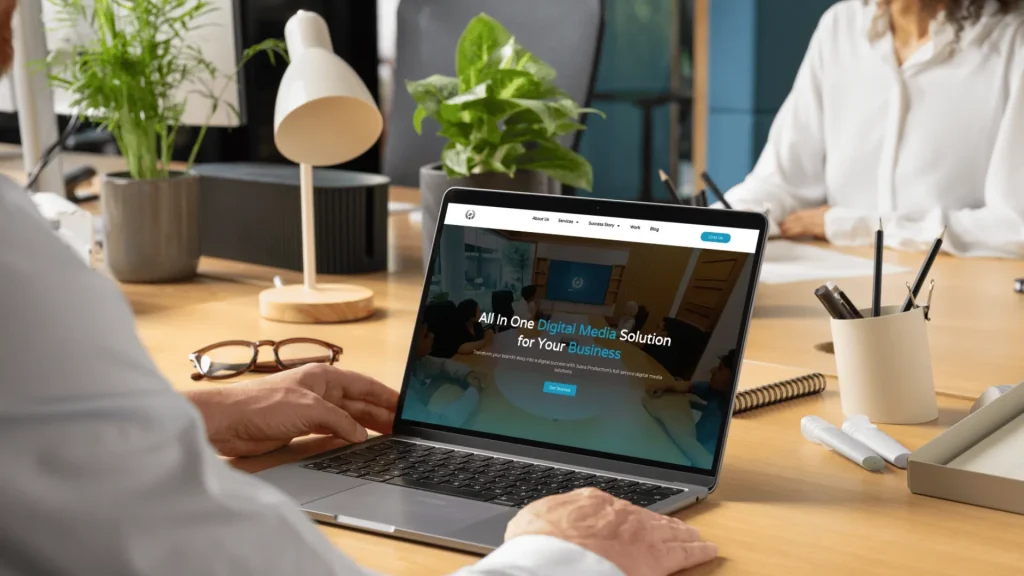What is Website Development? Everything You Need to Know!
Oktarina
July 4, 2025
11 min read

Did you know that 70% of small businesses with a website see higher customer engagement? If you’re still questioning the need for a website, you’re missing out on a powerful tool that can elevate your business. So, what is website development? Put, create, design, and maintain a website to establish a strong online presence. In this digital age, website development is crucial for businesses, e-commerce platforms, and personal brands to connect with customers and grow their reach.
In this article, we’ll explore what website development is, why it’s vital for businesses, and the key components involved. Whether you’re looking to launch your first website or optimize your current one, we’ll also dive into the benefits of professional development and provide a step-by-step guide on how to get started.
What is Website Development?
Website development involves creating, designing, and maintaining a website. It consists of both front-end and back-end development. Front-end development focuses on the visual and interactive parts of the website—what users see and interact with, like the layout, colors, buttons, and text. It ensures the website looks good and works smoothly on devices like desktops, tablets, and phones.
On the other hand, back-end development deals with behind-the-scenes functionality, such as managing databases, handling server requests, and ensuring security. This part of the development ensures the website runs properly and data is processed correctly.
Developers build a website using coding languages like HTML, CSS, JavaScript, and PHP. HTML structures the content, CSS styles it, JavaScript adds interactivity, and PHP handles dynamic content and server-side functions.
Once the website is built, it needs regular maintenance to keep it secure, updated, and running smoothly. This includes fixing bugs, improving performance, and ensuring everything stays current.
In short, website development is about creating a functional, visually appealing, and easy-to-use platform that serves the needs of a business, brand, or personal project. It combines design, coding, and ongoing care to ensure a seamless user experience.
Why is a Website Essential for Business?

A website is a critical tool for your business—it acts as your digital storefront. It’s often the first place potential customers interact with your brand, making it key to your business success. Here’s why having a website is essential:
- Increased Visibility
A website ensures your business is available 24/7 to a global audience. Potential customers can find you at any time, from anywhere, increasing your reach far beyond your local area. - Credibility & Trust
A professional website builds trust with your customers. It showcases your products, services, and expertise, helping customers feel more confident doing business with you. Clear contact info, secure payment options, and customer testimonials add to your brand’s credibility. - Lead Generation & Sales
Your website can generate leads and drive sales. With features like contact forms, e-commerce options, and newsletters, you can capture customer interest and convert them into buyers. A website can even work for you around the clock, selling products or services anytime. - Competitive Advantage
In today’s digital world, businesses without a website risk falling behind competitors. A website helps you stay competitive by giving your business a professional online presence that customers expect. - Customer Engagement
Your website can engage customers through blogs, FAQs, live chat, and social media links, making it easier for them to interact with your brand and get the support they need.
Read more: Why is a Website Important for Business? Discover the Reasons and Benefits
Key Components of Website Development

Website development is a detailed and multi-faceted process that ensures a website works smoothly, remains secure, and provides an engaging user experience. Each component significantly ensures the site meets its objectives and provides the best possible functionality. Below is a detailed breakdown of the key elements involved in website development:
1. Front-End Development
Front-end development refers to the part of the website that users interact with directly. This includes the visual aspects such as the layout, design, colors, fonts, images, and interactive elements like buttons, menus, and forms. Front-end developers use various technologies to create these components, most commonly HTML (HyperText Markup Language), CSS (Cascading Style Sheets), and JavaScript. HTML forms the page’s structure, defining elements like headings, paragraphs, and links. CSS is responsible for the presentation, controlling the design and layout of the site, making it visually appealing and easy to navigate. JavaScript adds dynamic behavior to the site, enabling form validation, interactive menus, and animations.
A key focus in front-end development is ensuring that the website is responsive. It adjusts seamlessly to different screen sizes, whether a user is on a smartphone, tablet, or desktop. This responsiveness is essential in today’s mobile-first world.
2. Back-End Development
Back-end development is the server-side component of a website that operates behind the scenes to ensure everything runs smoothly. It involves managing databases, handling server requests, and ensuring the website operates correctly by processing data and delivering it to the front end. Back-end developers work with programming languages such as PHP, Python, Ruby, Node.js, and Java to create the logic that powers the website. These languages allow developers to build systems for user authentication, data storage, and communication between the front end and the server.
The back-end also involves working with databases, where crucial information like user profiles, blog posts, and product details is stored. Standard database technologies include MySQL, PostgreSQL, and MongoDB. Another essential aspect of back-end development is ensuring the website’s security, such as encrypting data and protecting it from attacks like SQL injection or cross-site scripting. The back-end ensures that user interactions, such as filling out a form or purchasing, are processed and returned to the user without issues.
3. Full-Stack Development
Full-stack development refers to the combination of front-end and back-end development, meaning full-stack developers are skilled in managing a website’s user interface and server-side functionality. These developers are versatile and capable of handling every aspect of the website, from its visual design to its core functionalities. Full-stack developers have a broad understanding of web technologies, which allows them to handle tasks such as designing the layout and structure of the site, writing code that powers server-side functions, managing databases, and integrating third-party applications or APIs.
They work across the entire development process, ensuring the website runs efficiently from the front end to the back end. Full-stack developers are also responsible for ensuring the front-end and back-end components work seamlessly together, providing a cohesive and functional user experience. Their broad skill set allows them to manage the entire lifecycle of a website, from planning and development to deployment and maintenance.
4. Content Management Systems (CMS)
A Content Management System (CMS) is a platform that allows users to create, manage, and update website content without requiring coding knowledge. CMS platforms provide an easy-to-use interface that simplifies the process of adding text, images, and videos to a website and updating product listings or publishing blog posts. WordPress, Joomla, and Shopify are examples of popular CMS platforms. WordPress is the most widely used, offering various themes and plugins that allow users to customize their sites easily. It’s ideal for creating business websites, blogs, and even e-commerce stores. Joomla is another CMS often used for more complex websites and applications. It offers greater flexibility but requires a bit more technical knowledge.
Shopify is a specialized CMS focused on e-commerce. It makes it easy to set up and manage an online store with integrated payment systems and inventory management. Using a CMS allows businesses to control their website’s content without needing a developer for every update, providing a user-friendly experience for website owners.
5. Website Maintenance
Website maintenance is the ongoing process of ensuring that a website remains up to date, secure, and functioning properly after its launch. This includes various tasks to maintain the website’s performance and security. Regular security updates are essential to protect against vulnerabilities, ensuring that software, plugins, and frameworks are updated as new patches are released. Another crucial aspect is performance monitoring, which involves checking that the site loads quickly and efficiently, even during periods of high traffic. Optimizing images, enabling caching, and improving server response times are some steps that help improve a site’s speed and performance.
Backups are another vital part of website maintenance. Regular backups ensure that the website can be quickly restored without losing valuable content or functionality in the event of a system failure or data loss. Additionally, content updates are necessary to keep the website relevant and engaging. This may include updating blog posts, adding new product listings, or revising company information. Regular website maintenance ensures the site remains secure, functional, and aligned with the business’s evolving needs, providing users a positive and safe experience.
Benefits of Professional Website Development
Investing in professional website development offers several key advantages over DIY website builders. Here’s why it’s worth the investment:
- Enhanced Credibility
A professionally designed website creates a strong first impression and builds trust with visitors. It looks polished, reflects your brand’s identity, and shows that your business is serious and reliable. A well-designed site establishes your authority in your industry and makes visitors more likely to engage with your company. - Improved SEO Performance
A professional website is built with SEO best practices in mind. This means it’s more likely to rank higher on search engines like Google. Optimized elements such as fast load times, responsive design, and well-structured content help increase your website’s visibility and drive organic traffic, bringing more potential customers to your site. - Superior User Experience
A professional website ensures visitors a fast, mobile-friendly, and easy-to-navigate experience. A seamless user experience reduces frustration and increases engagement, keeping visitors on your site longer and improving the chance of conversion. - Increased Conversions
Professionally developed websites include strategic calls to action (CTAs) that encourage users to take action, such as signing up or purchasing. These clear and persuasive CTAs help boost conversions, turning visitors into customers or leads. - Scalability
A professional website is designed to grow with your business. It can handle increased traffic, additional content, or new features as your business expands, saving you time and money in the long run.
Steps to Start a Website For Your Business

Building a website for your business is a straightforward process when you follow these steps:
- Define Your Goals
Start by determining the purpose of your website. Is it to increase brand awareness, make sales, or generate leads? Understanding your target audience is also key in shaping your site’s design and content. - Choose a Platform
Next, decide whether to use an easy-to-manage Content Management System (CMS) like WordPress or Shopify for a more straightforward setup, or go for custom development if you need more control and flexibility. CMS platforms are ideal for businesses looking for quick results, while custom-built websites offer greater customization. - Plan Design and Features
Consider your website’s layout and essential features, like mobile-friendliness, e-commerce, blogs, or contact forms. Create wireframes to organize these elements and ensure they meet your business needs and customer expectations. - Develop and Test
Build the website based on your plan, whether using a CMS or custom development. Once built, test the website across devices and browsers to ensure it works well everywhere and loads quickly. - Launch and Maintain
After testing, launch your website. Regular maintenance, such as updating content, checking security, and backing up your data, is essential for running the site smoothly. - Work with a Professional Developer
If you want a more customized solution or don’t have the technical skills, consider partnering with a professional website developer like Juara Production, to create a site tailored to your business needs.
Read more: Website Development Service in Bali: A Digital Solution for Your Business
Build Your Website with Juara Production!
Your website is one of your business’s most important digital strategy components. In today’s fast-paced, online-driven world, a well-designed and fully functional website can help you connect with potential customers, establish your brand, and drive long-term growth. A strong online presence attracts visitors and converts them into loyal customers. Whether you want to showcase your products, share valuable content, or enhance your customer service, your website is a powerful tool to achieve all this.
If you are ready to elevate your business and establish a solid online presence, consider working with Juara Production, a trusted provider of professional website development services. Our team of experts specializes in creating customized, SEO-optimized, and user-friendly websites designed specifically to meet your unique business needs. With our Digital Agency service in Bali, we understand that every business is different. That’s why we work closely with you to design a website that reflects your brand identity, resonates with your target audience, and aligns with your business goals.
Ready to boost your business with a stunning, fully functional website? Contact Juara Production today and let us help you create a website that drives results and enhances your brand. We’re here to make your online presence a success!





